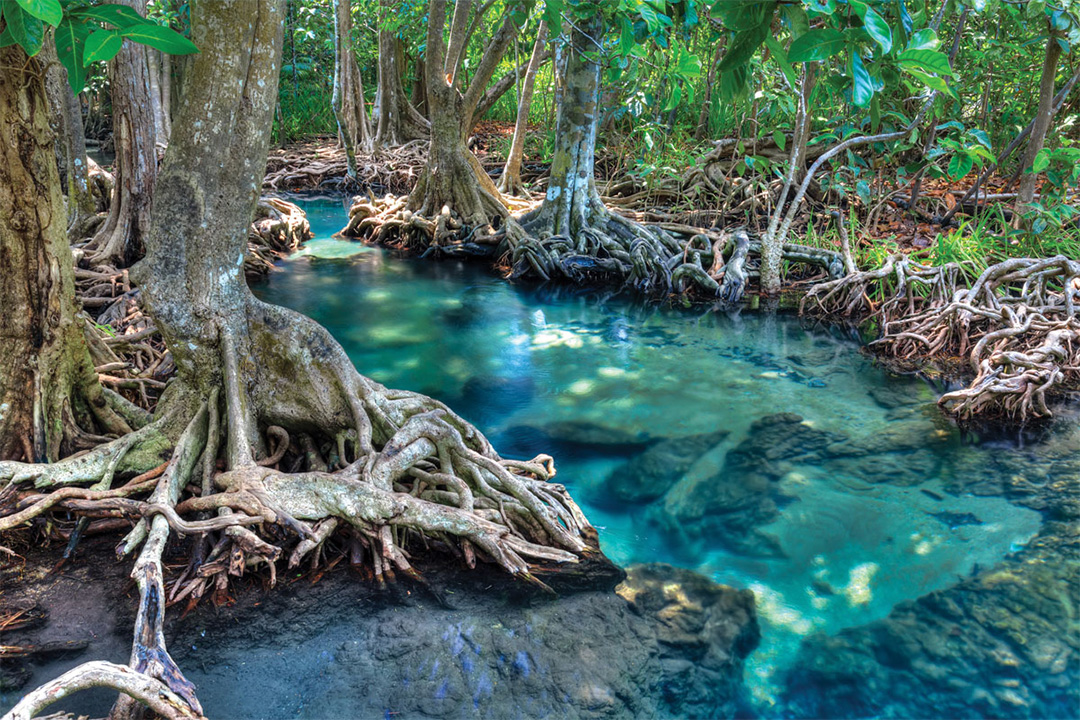Amid growing concern over deforestation, there is relatively little awareness of one of the more alarming aspects of this trend – the decline of the world’s mangroves.
Mangroves are among the wonders of our natural world. They are unique, land-and-water systems of trees and shrubs which are known for their beauty, but which also play a vital role in protecting and nourishing coastal and inland people and habitats while supporting an extraordinary diversity of life.
People in 128 countries and territories depend directly on mangroves for products like wood, fish, crabs, shrimps, clams and medicines, which are essential to their livelihoods, food security and nutrition. They are also protected by these ecosystems, which are uniquely adapted to saline environments. Mangroves are resistant to extreme tides and help to trap sedimentation. They help to stabilize shorelines, reduce flooding and mitigate other natural disasters by lessening waves and wind.
But they, too, have their limits. Coastal development, unsustainable agricultural and aquaculture practices and other factors have led to the rapid loss of the world’s mangroves.
Twenty percent of the world’s mangroves were lost between 1980 and 2005. This decline has already negatively impacted coastal communities, and threatens to increase the vulnerability of small-scale fisheries which depend heavily on coastal habitats. Any action to conserve and restore mangroves needs to address the various drivers of their degradation and loss, including those linked to human activity.
Buffers Against Climate Change
Increasingly, mangroves are being negatively impacted by climate change, including extreme weather events, strong winds, powerful waves, rising sea levels, and changes in soil, pest populations and disease. This is particularly worrisome as mangroves are also one of the earth’s major allies against climate change.
Studies have found that, together with habitats such as tidal marshes, seagrass and meadows of algae, mangroves are among the world’s most capable systems when it comes to sequestering carbon, part of the process considered essential to slowing climate change.
The potential of mangroves to help fight climate change, conserve biodiversity, improve food and nutrition security and support human well-being underscores the importance of developing strategies and practices to sustainably manage these hardy but increasingly vulnerable ecosystems.
Sustainable management of mangroves can help to achieve the 2030 Agenda for Sustainable Development and its SDGs, including SDG 15 (life on land), SDG 14 (life under water) and SDG 13 (climate action). This is one area in which urgent policy formulation and action can help to lead the way.
Taking Action
Many countries have expressed determination to turn the tide against the loss and degradation of mangroves. At least 45 countries have specifically mentioned mangroves in their national plans to tackle climate change. Twenty-eight countries have mentioned mangroves in their restoration pledges, and as many as 62 countries have named them in their national biodiversity plans.
What is needed now is to convert this political will as quickly as possible into policy, planning and action on the ground and to take a holistic approach to conserve, restore, manage and use mangroves in a sustainable manner. For example, an action plan should take into account the fact that mangroves, seagrass meadows and coral reefs are interdependent ecosystems within coastal complexes and that changes in any one of these would affect the others.
But more can be done, and more needs to be done. With the urgent need to set more ambitious targets in the fight against climate change and biodiversity loss, countries have the opportunity to expand mangrove actions, for example, in the upcoming revision of their national climate contributions under the UNFCCC.
Keeping the world’s mangroves healthy will require a combination of integrated coastal management, governance that integrates policies across sectors, and the sharing of technical expertise and effective practices, in addition to efforts to improve the livelihoods and capacities of the people whose actions most directly affect mangroves, such as rural farmers, fishermen and harvesters of wood.
A holistic approach to protecting and restoring natural resources reflects principles which are already being applied by many countries to promote sustainable agriculture and development. As we observe the International Day for the Conservation of the Mangrove Ecosystem (26 July), we are reminded that mangroves, too, urgently need to be included in such efforts, before it is too late.
* * *
This article was written by Sheila Wertz-Kanounnikoff, Senior Forestry Officer, Forestry Policy and Resources Division, Food and Agriculture Organization of the UN (FAO), and Vera Agostini, Deputy Director, Fisheries and Aquaculture Policy and Resources Division, FAO.
